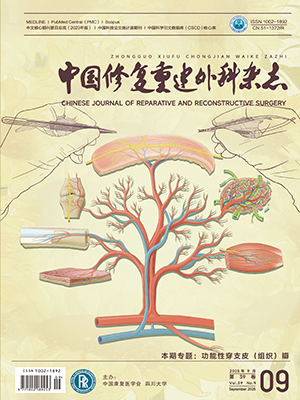Objective To evaluate the methods of the pedicle screw-rod fixationsystem combined with allograft bone or polymethylmethacrylate (PMMA) for the reconstruction of pelvic girdle after the complete resections of primary malignantbone tumor and the metastatic lesion of ilium. Methods From July 1999 to July2004, 16 patients with iliac malignant bone tumor were treated with the techniques of the complete resection and reconstruction. There were 9 males and 7 females at the age of 16 to 80 years. The 10 patients with primary malignant bone tumor included 4 cases of chondrosarcomas, 3 cases of osteosarcomas, 2 cases of Ewing sarcomas, and 1 case of malignant giant cell tumor of bone. The 6 patients with the metastatic lesion consisted of 2 cases of breast carcinoma, 1 case of lung carcinoma, 1 case of kidney carcinoma, 1 case of thyroid carcinoma and 1 case of prostate carcinoma. A solitary skeletal metastatic lesion was demonstrated in all metastases. There were 2 cases of stage ⅠA and 8 cases of stage ⅡB in primary malignant bone tumor according to the Enneking classification. The pedicle screwrod fixationsystem combined with allograft bone was used to reconstruct the pelvic girdle in primary malignant tumor. The patients with metastases underwent the pedicle screwrod system fixation with PMMA or without PMMA. The postoperative complication of reconstruction, local recurrence and bone healing were investigated. The postoperative function was analyzed according to the method reported by Enneking. Results The average followup was 35.6 months (5 to 65 months). Of all patients, 2had suspected deep infection, 2 had internal fixation loosening and 1 had nonunion of allograft bone. The mean healing time of the osteotomy site was 5.8 months (4.2 to 8.4 months). No immune rejection was seen. There were 2 patients with local recurrences, 3 patients with pulmonary metastases and 2 deaths due to metastases. The average functional score was 24.8(82.7%) in 8 survival. The functional results also were classified as excellent in 4, good in 3 and fair in 1. The median survival was 11.8 months (4.6 to 48.5 months) in metastases. Four patientshad lived for 1 year or longer after surgical intervention. The internal fixation loosening occurred in 2 patients, new destruction in 3 patients and no infectionoccurred. All patients immediately alleviated the pain and could walk with or without support after operation. At follow-up after 1 year, the average functional score was 21.7(72.3%). The functional results also were classified as excellent in 2 and good in 2. Conclusion Because of less complication and good function, the pedicle screwrod fixation system combined with allograft bone orPMMA are advisable for the reconstructions of pelvic stability after the complete iliac resections of primary malignant bone tumor and the metastatic lesion.
Citation: GUO Zheng,WANG Zhen,LI Mingquan,et al.. RECONSTRUCTIONS OF PELVIC GIRDLE AFTER RESECTIONS OF ILIAC MALIGNANT BONE TUMOR. Chinese Journal of Reparative and Reconstructive Surgery, 2005, 19(12): 966-970. doi: Copy
Copyright © the editorial department of Chinese Journal of Reparative and Reconstructive Surgery of West China Medical Publisher. All rights reserved




